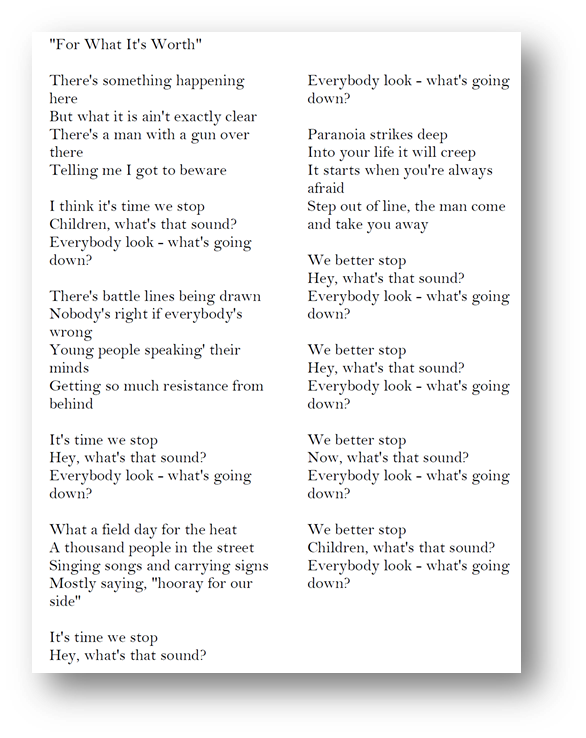Source #2 - Postmodernist Lyrical Poetry
- Big Nerd

- Apr 3, 2020
- 3 min read
Updated: Apr 29
This portion is due Wednesday, 7 May. Be sure to include live links.

Due Wednesday, 7 May 2025
Remember
As you Read/View each iconic work of Postmodernism lyrical poetry, consider these points:
1. Intertextuality/Pastiche - Look at how the work draws from established literary traditions and tropes, "samples" them - mocks them in both a literal and figurative sense.
2. Metafiction/Poioumena - Find the different ways the artist/author turns the camera back onto hirself, becoming part of the narrative zhe tells. At what point does zhe blur the lines between artist and audience, between creator and consumer?
3. Fabulism/Magical Realism - Recognize where the artist/author creates an ecosystem that is uncomfortably uncanny, magical, yet utterly photo-realistic.
4. Minimalism v. Maximalism - Find examples of the stripped down aesthetic of Postmodernist art and literature, then compare it to the sometimes baroque overindulgence of late-stage capitalism.
5. Other Components of Postmodernism from our KF - It's your choice!
Naomi Shihab Nye, "Making a Fist" (10 pts possible)


Radiohead "There There" (9 pts possible)

Cody Jinks, "Loud and Heavy" (7 pts possible)
Thanks for the suggestion, Sheepdog!

A Perfect Circle, "Orestes" (9 pts possible)

Buffalo Springfield, "For What It's Worth" (6 pts possible)

David Bowie - "Space Oddity" (7 pts possible)

Nnamdi - "Semantics" (10 pts possible)
CN: explicit language, reference to drug use

e.e. cummings - "[i carry your heart with me(i carry it in]" (8 pts possible)

AJ Vickers - "Texas Heat" (8 pts possible)
To Post:
1. Use your digital alias to post in the comments below.
2. Identify which video/lyrical poem you intend write about. Comment on one or more of the Postmodernist elements above. Identify yourself by your alias, identify the text or detail you intend to discuss, then offer your comment.
3. Add your reaction to the work, including applications of the messages to your own experience (do not be too specific if it is a personal anecdote - again, privacy) other works that this reminds you of (use hyperlinks here), and how they compare/contrast.
4. Include in your reactions:
embedded videos
headings & subheadings
GIFs/images
You'll get to use your responses to these works and other Nerdy comments in the forum for your Final Exam.
Check out this model comment from Ima Nerd about a Postmodernist poem.
(This poem is not one of your selections. It's for modeling purposes only.)
IMA NERD
COMMENT #2 - POSTMODERNIST POETRY
**MODEL RESPONSE**
Randall Jarrell, "The Death of the Ball Turret Gunner"
Summary
When I first read the poem, "The Death of the Ball Turret Gunner," by Randall Jarrell, I had a lot of questions. I asked, "What's a ball turret?" "What's flak, exactly?" "Fur?" and proceeded to look up background information. Here's some of what I found.
This is a ball turret, with a gunner inside:

(Photo: SilverWings)
Maximalism
It's like a barnacle or a pregnant belly underneath a fighter plane. They were used a bunch in WWII, and these gunners had really high mortality rates.
One of the reasons for the high mortality rate was because the ball turrets were tempting targets for the enemy - easy pickin's, the gunner hanging right there separated only by a little plexi-glass. Wikipedia describes the ball turret gunner as "forced to assume a fetal position within the turret with his back and head against the rear wall, his hips at the bottom...legs held in mid-air by footrests" (https://en.wikipedia.org/wiki/Ball_turret).
OK, that sounds like a cross between a fetus and a mother giving birth on a hospital bed.
Another reason being a gunner was so deadly is because when planes had to ditch without landing gear (often) the gunner attached to the belly had nowhere to go. The gunner was ground to death as the plane slid to a stop. (Wikipedia). Gruesome.

Intertextuality
So, when I reread Jarrell's poem where the gunner describes himself as "in his mother's sleep" like in a womb, awakening to "black flak and the nightmare fighters" only to be "washed...out of the turret with a hose," it sounds like the poem is describing an abortion.
Is that what Jarrell is getting at here? An old-fashioned way of saying this is that these soldiers, practically babies at 18 years old, were "cannon fodder." Materiel to be used, aborted, and discarded by the state. Is it commentary on countries who sacrifice the poor, oppressed, and vulnerable on the altar of war? It reminded me of two *more* recent works on this topic; yes, the bands were back in the day. The first one is System of a Down's song, "B.Y.O.B." [Content Note: Use of Expletives]
The second is A Perfect Circle's song, "Pet" or "Counting Bodies Like Sheep." [Content Note: Use of Expletives; Political Imagery]




Nye’s poem, “Making a Fist,” is a minimalist poem that uses intertextuality, pastiche, metafiction, magical realism, temporal distortion, and minimalism.
Nye’s openly uses intertextuality in her poem by first including a direct quote from Jorge Luis Borges’ The Book of Sand and Shakespeare’s Memory: “We forget that we are all dead men conversing with dead men,” The quote, which is placed before the poem, is a direct reference to the modernist theme of existentialism, in which death is viewed as an integral part of the human experience, limiting one’s time on earth, yet making every second of life more meaningful. If we are all here without a purpose and will inevitably die, then every moment you live is a moment…
Making a Fist
By Naomi Shihab Nye
When I first read the poem I had a lot of questions: “Where is Tampico?” “What is the symbolism behind ‘make a fist,’” and “What does it mean by ‘the borders we must cross separately’?” Here’s what I found. Tampico stands for a boundary between safety and the unknown. Making a fist symbolizes strength and survival. And the borders are the moments we have to face alone. These ideas show the poem’s deeper message about resilience.
The intertextuality in Making a Fist connects it directly to Moana through shared themes of strength and growth. In both, they follow young people who are dealing with fear, doubt, and even discovery. The “fist” in Nye’s poem works…
“Making a Fist” by Noami Shibab
Okay, so Naomi Shihab Nye’s poem “Making a Fist” might be short, but wow, does it pack a punch (pun intended). It starts with a kid in the backseat of a car, feeling sick, and asking a very intense question: “How do you know if you’re dying?” And her mom just drops this gem of wisdom: “You can’t die if you can make a fist.”. In a weird way it makes sense though. It’s bizarrely comforting and kind of hilarious. Like, thanks Mom, good to know that death is apparently just a matter of hand strength.
What I love about this poem is that it’s very simple. It feels like just a memory, a kid on…
EmoGoddessQueen-6th
“Making a Fist” by Noami Shibab
Link to the Lyrical poem here!
Summary: The speaker reflects on a childhood memory when she felt ill during a long car ride with her mom. Her mom sensed her distress, and taught her how to make a fist. This symbolizes the power to endure pain and keep going through adversity.
This lyrical poem depicts the themes of resilience and strength through overcoming challenges.
The poem conveys a sense of emotional growth, showing how the simple act of making a fist becomes a lasting lesson in perseverance and inner strength. The mother’s guidance is a powerful message to her daughter about the importance of holding on in difficult times, even how hard it…
testing